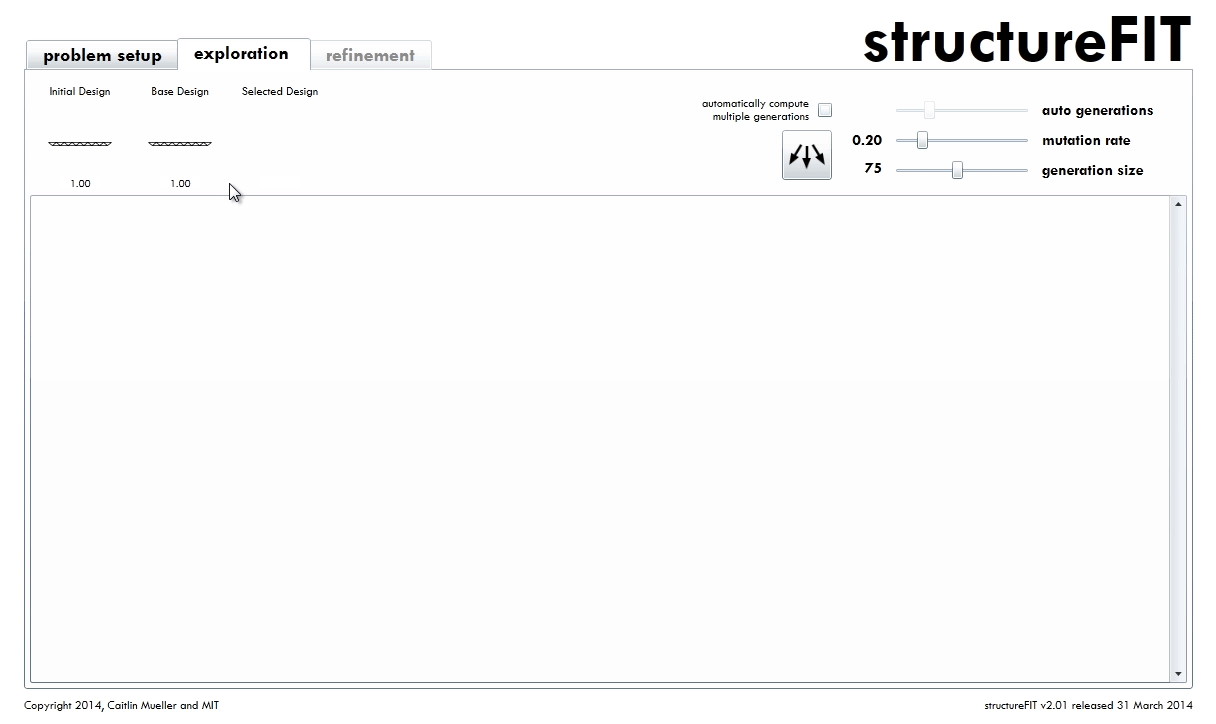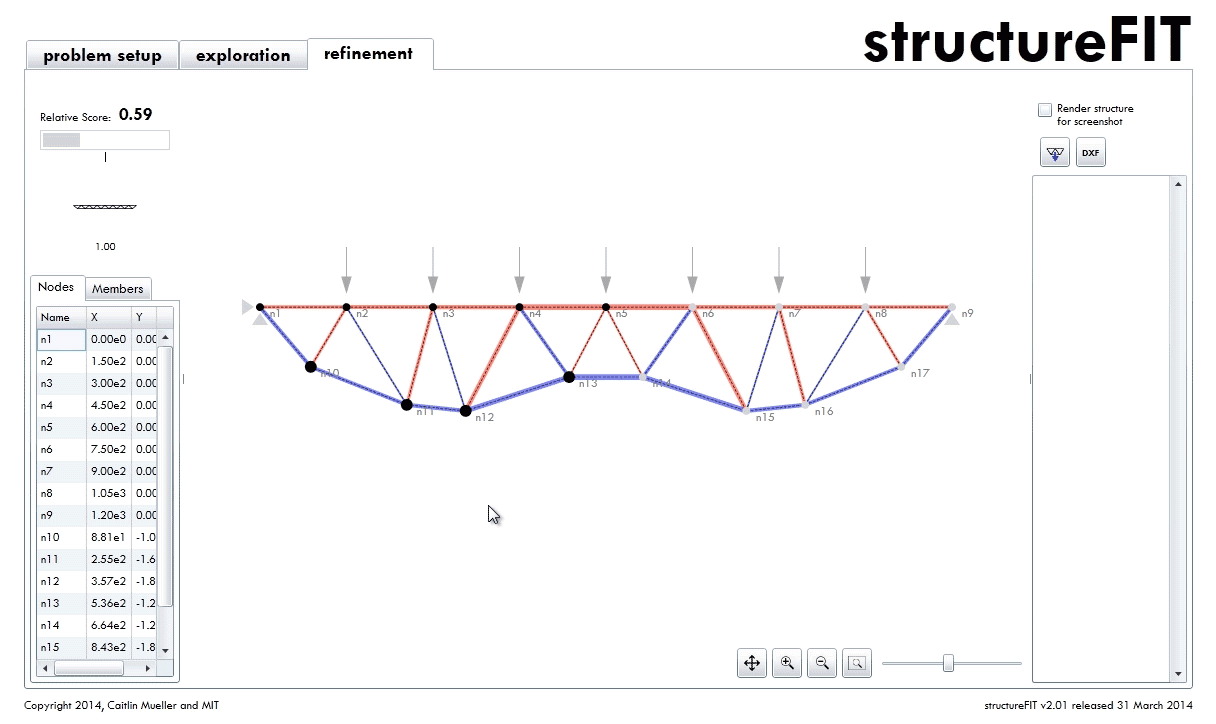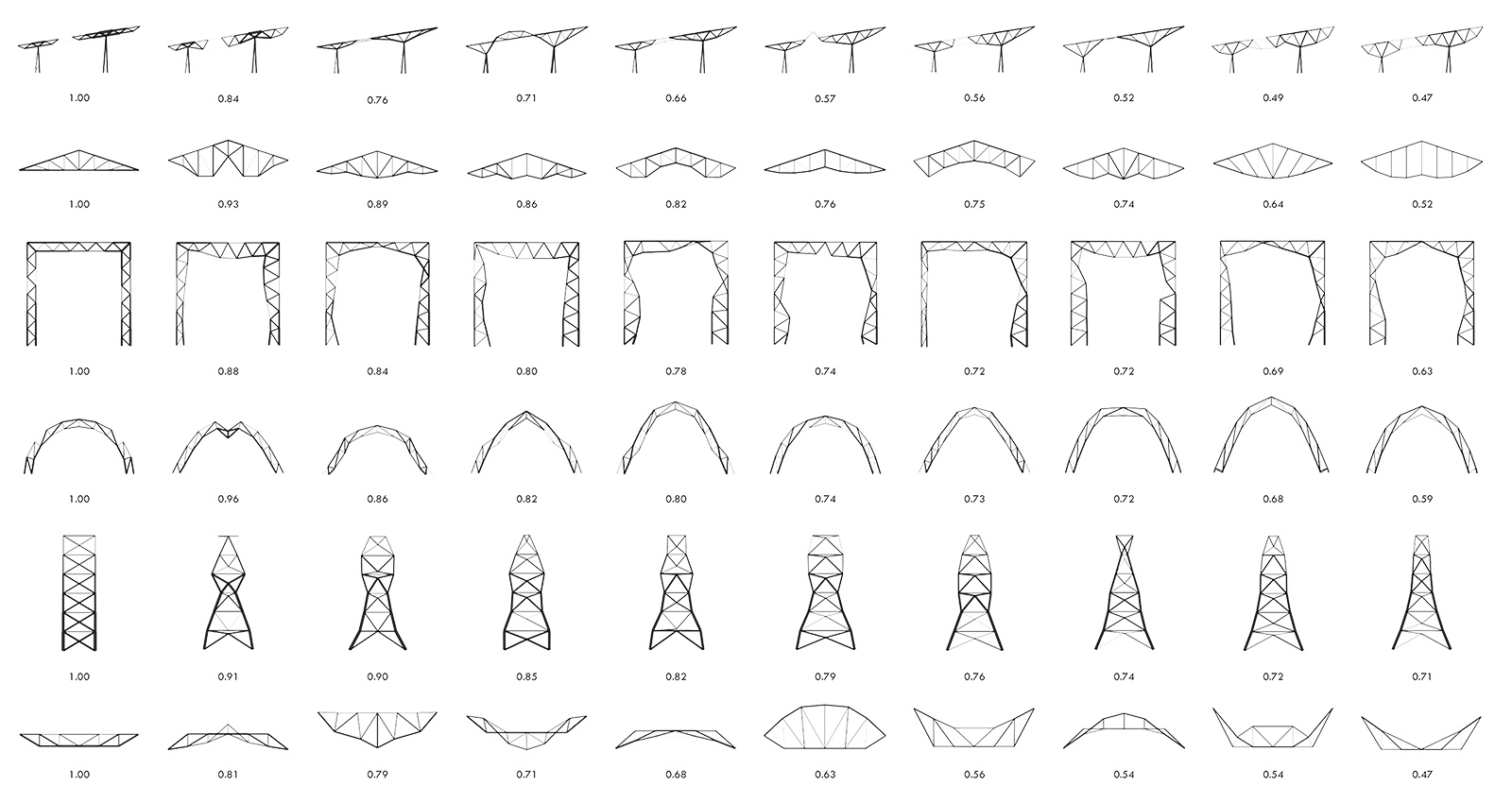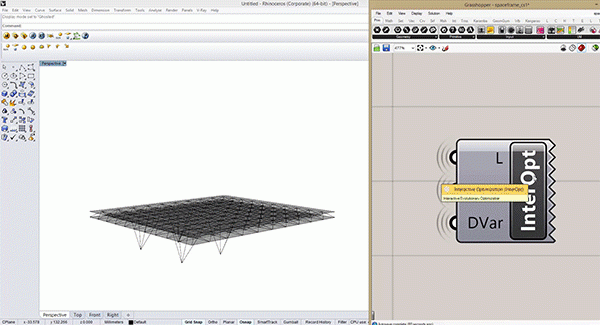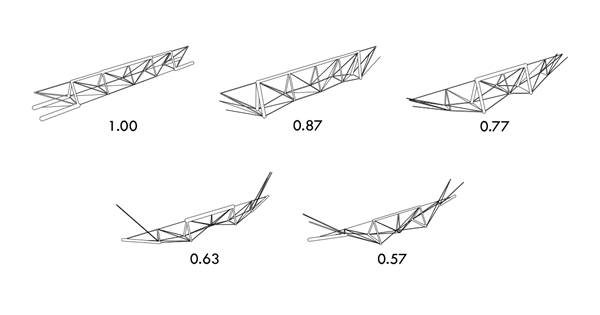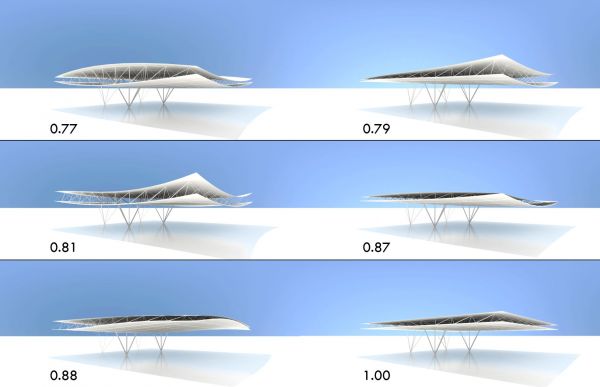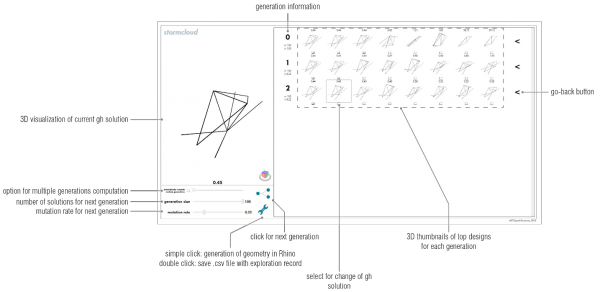structurefit
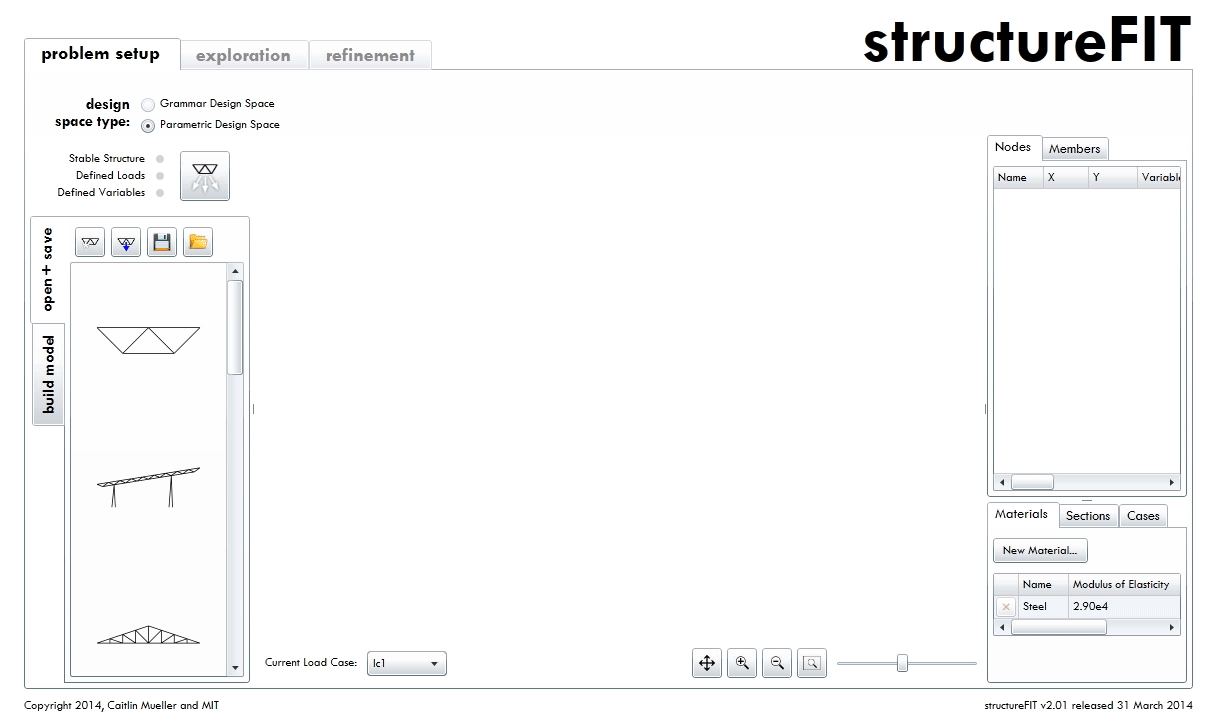
Digital Structures' first interactive design tool, structureFIT, is a free web-based platform for exploring the structural design of planar trusses. Based on an interactive evolutionary algorithm, the tool allows designers to navigate design spaces that link geometric design variables with structural performance in a flexible and creative way. The tool is organized into three phases: problem setup, where an initial design and variables are input, exploration, where designers can iteratively generate and select design alternatives, and refinement, where designers can make changes to a selected design and observe performance implications in real time. Performance is indicated by a numerical score that reflects required structural material volume, normalized by the volume of an initial design, and includes stress and buckling considerations. For more technical and detailed information about structureFIT, see here and here.
To access structureFIT, you must have Silverlight installed in your web browser. Unfortunately, this technology has been deprecated and is no longer supported by default in common browsers like Google Chrome. However, it is still possible to use structureFIT by either enabling your browser's NPAPI plugins (e.g. in Chrome) or by using Microsoft's Internet Explorer. Once your browser is correctly configured, you can start using structureFIT here.
Since the development of structureFIT, Digital Structures has focused on extending the tool's underlying principals of design freedom and directed exploration to other platforms, including popular parametric design interfaces such as Grasshopper and Dynamo. Our ongoing work in this area is summarized in the Parametric Plugins section below.
parametric plugins
-
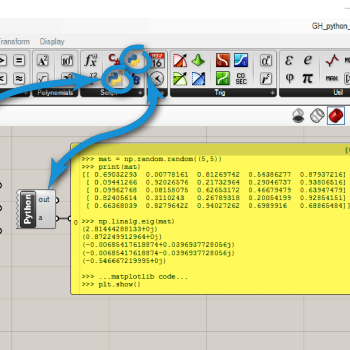 GH Python Remote2017 - Present
GH Python Remote2017 - Present -
 Design Space Exploration tool suite for Grasshopper2015 - Present
Design Space Exploration tool suite for Grasshopper2015 - Present -
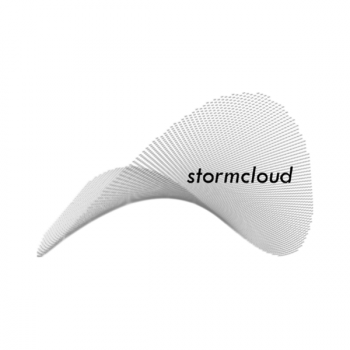 Stormcloud: Interactive evolutionary exploration for Grasshopper2014 - 2015
Stormcloud: Interactive evolutionary exploration for Grasshopper2014 - 2015
GH Python Remote
2017 - Present
GH Python Remote is a special set of tools in Grasshopper that let you use regular Python code directly in the GHPython component. This means you can use numpy, scipy, matlplotlib et al. right inside of Grasshopper! Installation instructions are on the Github page.
GH Python Remote works by connecting GHPython to an external instance of Python that runs all the usual programs. This augments the GHPython component to get the best of both worlds: your code will be able to call both RhinoCommon functions and regular Python packages from the same script. The dependencies are as limited as possible, and the installation is just to two command lines. The connection between GHPython and the remote Python is as fast as possible, and does not slow down when the size of your objects increases.
The component is still very flexible. For example, it will also let you connect to Python servers running on external machines, bringing the power of the cloud to your Grasshopper. Another example: it also works the other way, controlling Rhino and GHPython from an external Python program. And it's all open source!
Related group members:
Tags:

Design Space Exploration tool suite for Grasshopper
2015 - Present
Design Space Exploration (DSE) is a suite of open-source Grasshopper tools developed by Digital Structures at MIT. These tools aim to support visual, performance-based design space exploration and interactive multi-objective optimization (MOO) for conceptual design. Rather than one single component or user interface, these tools can be used flexibly with other Grasshopper components or plug-ins to take a variety of approaches to DSE and MOO, including a priori, a posteriori, and interactive articulation of performance priorities. Various DSE components allow the user to sample a parametric design space made from sliders, automatically iterate and capture images and numerical properties, reconstruct previous designs, cluster designs into families, analyze the importance of design variables, approximate computationally-intensive performance evaluations, and find Pareto fronts for multi-objective problems. Although the components are intended to link together for simple, automated workflows for performance-based design of buildings and other structures, they can be used for any applications that require these functionalities within Grasshopper.
This tool suite is available for download at Food4Rhino here, and the source code is on GitHub here.
DSE User Manual:
Link to download:
Related group members:
Tags:

Stormcloud: Interactive evolutionary exploration for Grasshopper
2014 - 2015
Based on the framework developed for structureFIT, Stormcloud is a new component for Grasshopper and Rhino that allows any parametric model to be explored using an interactive evolutionary framework, combining quantitative performance analysis with qualitative designer input. Unlike structureFIT, Stormcloud can work with any model and geometry type that can be represented and analyzed in Grasshopper. The quantitative analysis is also flexible: it can use structural weight, like structureFIT, but users are also free to input their own objective functions computed using other plugins or user-defined expressions.
Stormcloud is currently available for download as part of the Design Space Exploration tool suite on at Food4Rhino here.
Related group members:
Related publications:
Tags:

collaboration database
In building design, the concept of authorship is shifting from the traditional notion of the sole architect to a recognition of the modern team-based approach. In particular, the role of the structural engineer as a design partner is increasingly acknowledged, documented, analyzed, and celebrated. Recent books and scholarly articles present a range of contemporary and historical case studies in architect-engineer collaboration that show various ways successful, discordant, and other types of relationships impact design quality. These case studies also often highlight the specific design contributions of engineers, which are frequently overlooked in conventional architectural history work.
While useful, such case studies tend to present isolated examples in small numbers and without sufficient context. Widespread knowledge and publicly available information about engineers’ involvement in important building projects is still lacking. Even simple data, such as the name of the structural engineer involved with a project, goes unmentioned or is only reported as a side note or anecdote in many accounts. Fundamental questions of which engineers have worked with which architects on which projects remain difficult to track down answers to. This limits the design and research community’s ability to recognize excellence in structural design, and to qualitatively measure the impacts of structural engineers on architectural creations through comparative analysis. For example, structural engineer August Komendant (1906-1992) was a notable collaborator of architect Louis Kahn (1901-1974). However, questions of his precise impact on Kahn’s celebrated work, which could be analyzed by comparing Kahn’s buildings designed with Komendant to those designed without, remain open. There is a strong, unmet need for a centralized repository of key information related to design partnerships and collaborations to provide fundamental knowledge in a consolidated, organized manner, and to support further scholarly work in this field.
Digital Structures is currently undertaking a new research project aimed at addressing this issue: a new web-accessible database that contains fundamental information on design collaborations for hundreds of architecturally significant projects. Powerful visualizations allow users to quickly understand relationships between architects and engineers, including which designers worked together, patterns and contrasts related to design partnerships across projects, and accomplishments and impacts of various individuals. Through an intuitive graphical interface, users can sort projects by a number of useful metrics, including architectural program, structural system, primary materials, geographic location, scale, and decade.
This database and visualization tool are still under development, but will eventually be accessible here.


